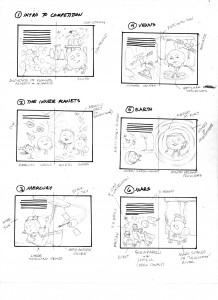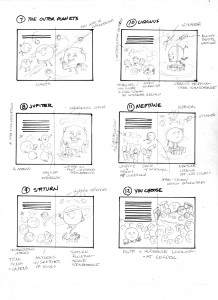Okay, so the “best laid plans” as they say (tho why Mice and Men both have plans that often go awry still escapes me). I fully intended to write about the “Meet the Planet” illustration process – AS I DID IT – but here i am, nearly finished with the pencil rough sketches and not a written word to be seen since the initial intro. Actually i think this step was kind of addressed in an early chapter of “Fur and Feathers” – i always seem to be juggling numerous projects simultaneously so free time is at a premium and finding time to sit and write often difficult. And, i’ll be honest, sometimes – after drawing all day – i really just don’t want to tax my brain any more with creative musing and the last thing i want to to do is try and wring out any more creative juices in the form of literary analysis. However, things are zipping right along and i don’t want to get any farther behind. So, by way of quick recap…
I got the new manuscript on February 11, with pencil roughs due April 9, and immediately ran off to the bookstore scooping up everything i could find on planets, astronomy, the universe, galaxies, and space. I already have a fair number of reference things at home (Carl Sagan’s “Cosmos” – book and DVD, “Comet” and “Murmurs of Earth”, a Time/Life series on natural history and the universe, a stack of Kids Discover and Scientific America magazines, an eclectic Star Wars and Dr. Who collection) so after adding to the library coffers i simply spent the next several weeks reading and absorbing and musing. I got so caught up in all the wonderful extraneous details and information in fact i kind of lost track of time and suddenly realized it was the first week of March and i had yet to put pencil to paper. But my mind was at least full of possibilities!
Per a pattern that was established with the very first book i did for Sylvan Dell (“If A Dolphin Were A Fish”) i began with small thumbnail sketches of each page, to make sure SD was comfortable with the direction i intended to take. This book is quite the departure from the nature-based animal books i’ve done in the past and the sky (or the cosmos) really was the limit in terms of stylistic direction. This is the kind of project i just go crazed over – a seemingly simple little, self-contained topic that winds up embracing everything from history and literature, to invention and philosophy, to mythology and art, to several branches of science and classical music. And don’t even get me started on pop culture possibilities.
I finally started roughing out the thumbnail sketches the first Friday in March (3/ 5) and got into such a groove i finished them up that following Wednesday (3/10). The small rough drawings gave a pretty fair idea of what the finished full-size pages would/will ultimately look like, but there was so many other little details involved i wound up including a little explanatory note for each page. And those, more than anything, best describe the process.
Per the attached note that accompanied the sketches:
*I’m using Stonehenge as a backdrop/stage for the “Competition”. I wanted to bring the “History of Astronomy” element, and while there is some debate about what the standing stones mean, most people seem to agree they were erected to record certain celestial events and it’s instantly recognizable as such. It’s something of an iconic monument (better known than the Chomsung Dae Observatory in Korea for example).
*I’m still developing the actual look/personalities of the planets – but i’m pretty much leaning toward keeping them actual “planets” (as opposed to some sort of human incarnation), with unique expressions and simple appendages.
As for specific visual features of each page (that may need some explaining):
Page 1 – Intro to the Competition: The audience will be largely in shadow and silhouette but comprised of personified moons, comets, as well as historical figures and icons affiliated with space, astronomy, science fact and fiction, etc. Our spiral galaxy (Milky Way) is in the corner.
Page 2 – Intro of the Inner Planets: All 4 – in their respective garb/persona. Big sun (wearing sun glasses). Asteroid belt in distance.
Page 3 – Mercury: In classic pose of statue of Mercury (with winged helmet and boots). Huge sun behind massive stones – to emphasize he’s small. Followed by the “Messenger” space probe (which goes into orbit around the planet in 2011).
Page 4 – Venus: Play on Botticelli’s “Birth of Venus” with Voyager, Venera, and Mariner space probes playing the part of the three surrounding angels. Venus stands on a representation of her flat planetary volcanoes (rather than a clam shell).
Page 5 – Earth: “Mother Earth” wears a crown of daisies and carries flowers (or something “natural”). She is surrounded by the different atmospheric layers (light blue to black – or real dark blue). North Star (Polaris) and circumpolar stars.constellations shown. Moon applauds.
Page 6 – Mars: In Roman warrior attire standing on “Sojourner” rover chariot. Towering standing stones to help make him look smaller than Earth and Venus. In audience: Schiaparelli and Lowell (who drew the canals), the two lumpy moons, H. G. Wells (reading “War of the Worlds”), some aliens/Martians, and robots. Again Polaris and constellation where Mars might be best located (in 2010-2011 – if possible. Otherwise it will be an historic reference).
Page 7 – Intro of the Outer Planets: Similar idea as the intro of the Inner Planets – only with the Sun (and the rest of the solar system) far away. Some comets circle around.
Page 8 – Jupiter: Dressed as a Roman god (or Caesar). One foot on Stonehenge it buckles under his weight. In the audience are the 4 biggest “Gallean” moons (discovered by Galileo, who is also in the audience). Sitting beside Galileo is Magellan who discovered the Magellanic clouds (and navigated by them) – which are in the background behind Jupiter.
NOTE: With the Outer Planets i’m trying to introduce different discoveries and observations way out in the cosmos (such as the Magellanic clouds).
NOTE: As with the Inner Planets i’m also attempting to have the North Star and a reference to a significant constellation (either where the planet can be found in 2010/2011, or where it was discovered originally) in each illustration. In Jupiter’s case – one of his moons, Callisto, is named for the woman Jupiter/Zeus turned into Ursa Major (along with her son, who became Ursa Minor).
Page 9 – Saturn: He’s suave, touching the “brim” of his ring as if he were tipping his hat. He’s floating above Stonehenge (being the lightest of the planets). Behind him are the different types of galaxies, as discovered by Hubble (who is in the audience). Also in the audience – 3 or 4 of Saturn’s distinctive moons, as well as Christian Huygens – who discovered the rings (he’s holding a copy of the sketches he made).
Page 10 – Uranus: He is tripping over Stonehenge – to account for orbiting on his side. His odd moon, Miranda, is hiding her eyes (it was thought she was broken apart and fused back together by gravity – thus explaining her fractured appearance. Or maybe because Uranus fell on her). We are getting into deep space now so the Voyager probe as well as a binary code message are in the background. In the audience are Herschel (who discovered Uranus) and his sister (who was an astronomer in her own right, and also helped Herschel. She supposedly fed him sandwiches while he worked so she’ll have a plate in hand). With the Herschels is Carl Sagan, holding the gold video disc that is carried by Voyager. The disc looks like a record and Herschel was also a musician – so i couldn’t help but make the connection. Herschel also discovered Uranus in the constellation Gemini – so that’s in the sky somewhere as well.
Page 11 – Neptune: Brooding and stormy (tho handsome) Neptune is standing on Stonehenge staring out into the cosmos – reflecting on what is beyond. Above him, in the distance, Voyager leaves the solar system heading to various galaxies, nebula, quasars, and black holes. Triton, the biggest moon, is going backwards. In the audience LeVerrie and Adams (who both, separately, discovered Neptune mathematically) are working out the equation on a chalkboard, while Galle (who took their computations and found the planet visually) looks thru a telescope.
NOTE: Neptune – moving so slowly – can be found in the constellation Aquarius until 2012. He also completes his first orbit around the Sun in 2011 (since being discovered!) so if i can figure out a way to illustrate that i’ll include it.
Page 12 – You Choose: This one is pretty obvious. Kind of a mirror of the first page with Pluto and the audience all looking at the reader. The audience will be filled with planets and aliens and historic/scientific figures, and all the planets will be “on stage” together.
On March 10 i received an e-mail from Sylvan Dell: I love where you are going with this! I think you are having fun…
And the fun continues………….

